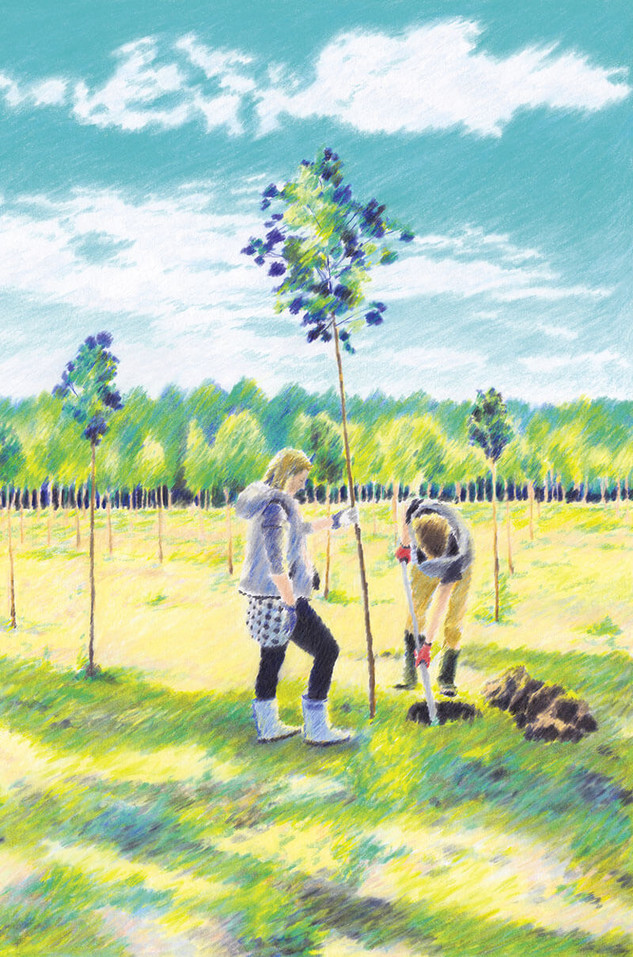
Forests in the age of climate change
Contributors
Nathalie Barbe
Director of institutional relations of the National Forestry Office (ONF), responsible for the management of French public forests.
Alain Karsenty
Researcher - economist specialising in forests at CIRAD (Centre for International Cooperation in Agronomic Research for Development)
Éric Toppan
Deputy general manager of Fransylva
In recent months, forests have been at the heart of the news. They burned, everywhere, indiscriminately, and in unprecedented numbers. A single figure sums up the full extent of the damage: 508,260. This is the number of hectares that have gone up in smoke across the European Union that EFFIS (the European information system on forest fires) has identified between 1st June and 31st August 2022 – more than double the annual average recorded over this same period between 2006 and 2021 (215,000 hectares).
In France, the second hardest-hit European country after Spain, the cost is even greater: this year, 62,000 hectares have been gutted by summer forest fires, when losses usually amount to around 10,000 hectares over the same period. So by force of circumstance, forests have become yet another ‘hot’ topic on the political agenda. After Emmanuel Macron announced a “major national replanting project” for the forests ravaged by the flames in July, his Prime Minister Elisabeth Borne then confirmed that forest and woodland would be one of the three priorities (alongside water and carbon-free energy) of its 'ecological planning' policy, currently under consultation.
It is an urgent issue, warns Alain Karsenty, researcher - economist specialising in forests at CIRAD (Centre for International Cooperation in Agricultural Research for Development). “For the past twenty years, the general state of health of trees and their mortality rate have been of concern.” Eric Toppan, Ceputy Managing Director of Fransylva, the federation which represents the 3.5 million private forest owners in France, agrees: “Forests are directly subject to climate change, the impacts of which are increasingly evident. Before, we had a drought perhaps once every twenty years, now it’s almost every year!”
The double effect of climate change
Under the combined effect of water stress and increased temperatures, trees weaken and are thus more vulnerable to bad weather and to pests, the proliferation of which is also caused by extreme climatic conditions – this is the famous ‘double effect’ of climate change. “Like any living being, the more fragile the trees, the less resistant they are to external factors like disease”, confirms Nathalie Barbe, director of institutional relations at the National Forestry Office (ONF), responsible for managing French public forests. “And in this context, disease is an increasingly important threat.”
An example of this is the damage caused by the bark beetle, a xylophagous insect that gnaws spruce trees in the north-east region of France. The fruiting and renewal of tree species are also impacted by drought. Compounding the issue, climate change affects even the natural regeneration of forests.
Before, we had a drought every twenty years, now it’s almost every year!
Yet for Alain Karsenty the irony is that “Forests provide an essential function in the carbon cycle, since they store around 26 to 27% of our CO2 emissions. At the forefront of climate change, forests find themselves among those victims most exposed to a phenomenon that they are precisely supposed to help combat.
When burning, forests suffer the consequences of climate change which they then contribute to by releasing into the atmosphere the CO2 previously stored in them1... However, it is this role as a carbon sink that still makes forests a leading ally in the climate battle. And so much more, by offering an incomparable refuge for biodiversity, necessary protection against soil erosion and even an efficient water filtration process. Forests guarantee a wide range of benefits for the environment.
1. In this case, fire-related emissions this summer will have reached a record level of 6.4 mega- tonnes of CO2 according to the European Copernicus Atmosphere Monitoring Service.
Considerable socio-economic potential
These ecosystem services have been valued at 970 euros per hectare of forest per year as part of the famous Chevassus- au-Louis report on the cost of biodiversity2. Such a pricing scheme attempts to measure all the essential ‘services’ provided by forests, whether environmental, energy or even cultural – consider for a moment the forest of Fontainebleau, the most frequented natural site in France, with 10 million visitors per year. We can also consider a country like Estonia. In this small country, located between Latvia and Finland, one of the most forested in Europe, the attachment to these spaces is such that Latvians consider themselves citizens of a ‘forest nation’.
“The idea is certainly not to say that you have to charge for access to the forests, on the contrary!” defends Éric Toppan. However, we must be able to better consider economic players as partners in this ecological balance. Without a better economic valuation of the forest, it is difficult to expect more sustainable management.” This is very much the case in France, where three-quarters of the forests are owned by small private owners who have to incur sometimes significant costs to maintain woodland. This is generally not common at a European level where forests are mainly in the public domain.
Finally, what could establish forestry as a major sector of the energy transition as well as at the same time, a lever for economic development? The figures speak for themselves: according to the World Bank, logging throughout the world would generate nearly 13.2 million jobs for a higher added gross value of 600 billion dollars per year. In Europe, where forests cover 159 million hectares (38% of the territory), the industrial sector which relies on the exploitation of wood resources — construction, stationery, heating, crafts - also represents significant socio-economic value. “The sector accounts for 20% of manufacturing companies across the whole of the European Union, which represents 3.6 million jobs and an annual turnover of 640 billion euros”, calculated the Commission in July 2021, when presenting its new forest strategy for 2030.
This is a trend that could well increase over the next few years, during which wood should establish itself as an important element of economic decarbonisation strategy. “Many of our public policies indicate that wood will become a strategic resource, confirms Nathalie Barbe. Take the new environmental regulation, the RE2020: it provides for an increased use of wood for the construction of new buildings. For his part, Eric Toppan is already seeing seismic shifts in the markets since the upheavals of the pandemic. “Demand for wood is exploding, especially since the Covid-19 crisis. This is probably part of an increasing concern for boosting the industrial sovereignty of the French economy: why deprive ourselves of this resource that we have, especially when it has so many advantages?” Unsurprising sentiments from the coordinator of the Economic Observatory of France Bois Forêt, the inter-professional body bringing together all the major trades in the sector. “Wood is good for everyone: for the environment, for the taxpayer and for our territories, since it helps create jobs that are literally impossible to outsource, and at the heart of rural regions!”
2. Economic approach to biodiversity and ecosystem services, report by the Centre for Strategic Analysis, chaired by Bernard Chevassus-au-Louis, April 2009.



Investments on the rise
Many such arguments have encouraged financial players to take a closer look at the sector and in turn increase their levels of investment. An example is the European Investment Bank (the shareholders of the EIB are the 28 Member States of the EU), which finances investment projects from both the private and public sectors, encompassing the entire forestry value chain, from production to transformation through research, development and innovation. The modernisation of a pulp mill in Sweden that included the regeneration and reforestation of 68,000 hectares of forest – almost three times the size of the Stockholm region is a good example. By granting a loan of 150 million euros to the company SCA, the second largest sawmill and the biggest private forest owner in Europe, the EIB will have thus enabled the absorption of more than 44,000 additional tonnes of CO2 equivalent per year.
The more fragile the trees, the less resistant they are to external factors like disease.

11 million hectares
This is the increase in European forest area, between 1990 and 2010, under the combined effect of its natural expansion and reforestation efforts. This makes the EU an exception, at a time when deforestation continues to ravage in the rest of the world.

3 billion
Is the number of additional trees that the European Union intends to plant by 2030. An ambition enshrined in the roadmap of the ‘new EU forest strategy for 2030’, which aims in particular to meet the objective of achieving carbon neutrality by 2050.

42%
This is the share of European wood intended for energy use. Around half of renewable energy consumption in the EU comes from wood. The rest is mainly intended for sawmills (24%) and the paper industry (17%).
Another way of financing is through business angel networks such as Forinvest, which has invested more than 8.5 million euros in 31 different companies since its creation in 2010.
“There is some catching up to do! For a long time, our sector was largely overlooked by financing mechanisms, both public and private. Now, all the indicators are green and show that investing in forests has become worthwhile!” And this also includes private investors, who can now turn to various products offering “forestry investment”, to diversify their assets, such as European Forest for example. Public authorities are not to be outdone and also seem to want to play their part in the effort. In any case, they underpin the France 2020 recovery plan, which has significantly raised the government’s ambitions with regard to forests. “With 150 million euros allocated in 2021 and 100 million in 2022, we are witnessing a great inflection”, says Nathalie Barbe. “Previously, public aid incentives were very low, at around 15 million euros per year...” The problem, as revealed by the NGO Canopée last spring, is that these new investments have mainly been used for the mass, monoculture plantation of Douglas pine, a species renowned for its rapid growth. Unfortunately, this is an operating model that should now be abandoned, as 600 scientists and associations reminded us in a column published during the last National Forest and Wood Meetings: “With increasingly frequent summer droughts, strip clearing large areas followed by replanting is an increasingly risky bet, as shown by the record mortality rates in young plantations in recent years.3 If financing remains, as is so often, the key factor, a real paradigm shift needs to be made in the field, to support forestry in transitioning towards more resilient practices that can adapt to climate shocks. A similar example can be found in Germany, which has embarked on a policy promoting the diversification of species.
Faced with the magnitude of the challenges, better European cooperation in the protection of forests could thus prove to be highly relevant. At the end of August, the European Commission launched a public consultation on the future legislative proposal relating to a new European framework for the monitoring and strategic planning of forests. However, for the time being, since the treaties do not expressly mention forests, the principle of subsidiarity applies and forest policy is still managed at the national level in each member state. In other words, unlike agriculture with the CAP, the European Union does not — as yet — have a policy or common budget allotted to this area. This situation is beginning to be felt across a range of issues, believes Nathalie Barbe: “Whether concerning the development of biomass or the fight against pests or imported deforestation, it would be useful to be able to think about certain public policies at the European scale. Like climate change, forests are more than ever a European concern”.
3. Column published in the Journal du Dimanche on 15 January 2022.
Forests store around 26-27% of our CO2 emissions.
Look further

THE REPORT
‘A new EU forest strategy for 2030’, communication from the European Commission, 16 July 2021.
A 32-page report detailing the challenges and prospects for action for the European Union in terms of forestry policy. (French report)

THE BOOK
The hidden life of trees, Peter Wohlleben (Harper Collins, 2017)
An ode to the life of forests and their benefits for society, helping to better understand the global role played by this ecosystem.

THE WEBSITE
The Portal of the IGN (National Institute of Geographic and Forest Information) which each year analyses the ‘Health report of French forests’
https://www.ign.fr/reperes/bilan-de- sante-des-forets-francaises/
(French website)

Artwork
Clément Thoby
Clément Thoby mainly creates landscapes with coloured pencils and from his travels, whether real or imaginary.

Text
Hugo Noig
Hugo Noig is a freelance journalist specialising in environmental and climate issues. For ten years, he has covered these issues for various newspaper and magazine titles.




